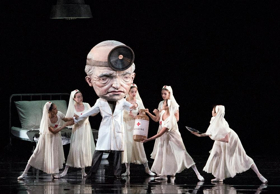BWW Dance Review: Alexei Ratmansky's 'Whipped Cream' at the Met, ABT, July 4, 2018.

Last year, almost to the day I saw it this time, I reviewed Alexei Ratmansky's new production for American Ballet Theatre of "Whipped Cream." With opulent scenery and costumes by Mark Ryden, expert lighting by Brad Fields, and music by the venerable Richard Strauss, this was a production that was designed to knock your socks off, not to mention knock you straight into the aisle. The money spent on it was, I imagine, prodigious, the reviews were just a bit right of ecstatic, the dance world was jumping.
A hit!!!!
Yet I remained totally unmoved. Like a number of Ratmansky productions I have seen, it seemed like money spent on productions that would not last long in the repertoire.
So what was the fuss?
Perhaps I spent way too much time figuring out the story's themes, wondering if the Richard Strauss music was really a good fit for any production, or if there was a reason for choosing to do the ballet.
Sometimes it's worth the time to just sit and think: Why??
Like the title, the ballet could seem overly sweet, you could gorge on it, and you came away with a stomachache. Unless you looked a bit beyond the facade. Or tried to.
So this time I just sat back and took the production as pure dance, nothing more. I didn't care about the libretto: a young boy gets sick eating whipped cream, his encounters with the Princess Praline, Princess Tea Flower (those names are a bit precious) and Prince Coffee; two monstrous headed characters, the Chef, the Doctor; plus a bevy of nurses, townspeople, whipped cream flakes. I don't need to go on. I'm sure you get it.
Sure, "Whipped Cream" seems like ABT's annual answer to "Nutcracker," another ballet that I don't think is really for children, forget the Christmas Tree, the mice and all those SAB students. You all know "Hansel and Gretel." It's about children, but not for them.
People just don't get it.
Let's try and look at "Whipped Cream" objectively. Once you get rid of all that syrupy junk, you realize that those two large-headed figures are not benevolent. They're things we might encounter in our nightmares. The nurses in attendance of the doctor could be Russian communists who want to induct us into the system, and if we refuse, we could be sent to Lubyanka. And the finale, where everyone comes together to celebrate the young boy's triumph over adversity, could be a cover for the great purge.
Maybe I know too much Russian history?
I wonder if Ratmansky thought this? Or maybe I'm reading a bit too much into all of this. After all, the ballet is part of ABT's plan to keep themselves well funded. And I don't blame the company.
Think of all those parents and children in attendance.
James Whiteside and Gillian Murphy as Prince Coffee and Princess Tea Flower were both excellent in their rather extended Act One pas de deux, following the endless line of the Strauss music. Strauss sometimes had the tendency to luxuriate in his music and was always criticized for this. But since Whitehead and Murphy are such wonderful dancers, the more intricate their pas de deux became, the better it became for dance lovers. It was just possible to enjoy it.
Gabe Stone Shayer in the role of the boy is not a natural comedian. He tries too hard, as they say, and for all his skimming footwork, I am not sure just what ABT management has in store for him. This will be interesting.
I have been impressed with Skylar Brandt-Princess Praline-for a long time, and I do hope she will be made a principal in the near future. The one thing she could use is a bit more grit, a backbone. She just doesn't hold our attention for a full 60 seconds, as it were. It's more like 47.
I think this is something that can be easily rectified with more performances and careful coaching.
The entire cast was captivating and the orchestra, conducted by David LaMarche, was first rate. Overall, this time it was a pleasurable afternoon. My guest, who had never seen the ballet before, found it witty, whimsical, and entertaining.
So did the audience. They all loved it. While I can't say that I was totally entranced this time, I have to admit that the ballet did provide intermittent pleasure.
Yet I still wonder what those large heads and nurses really represent.
Photograph: Gene Schiavone
Reader Reviews

Videos

